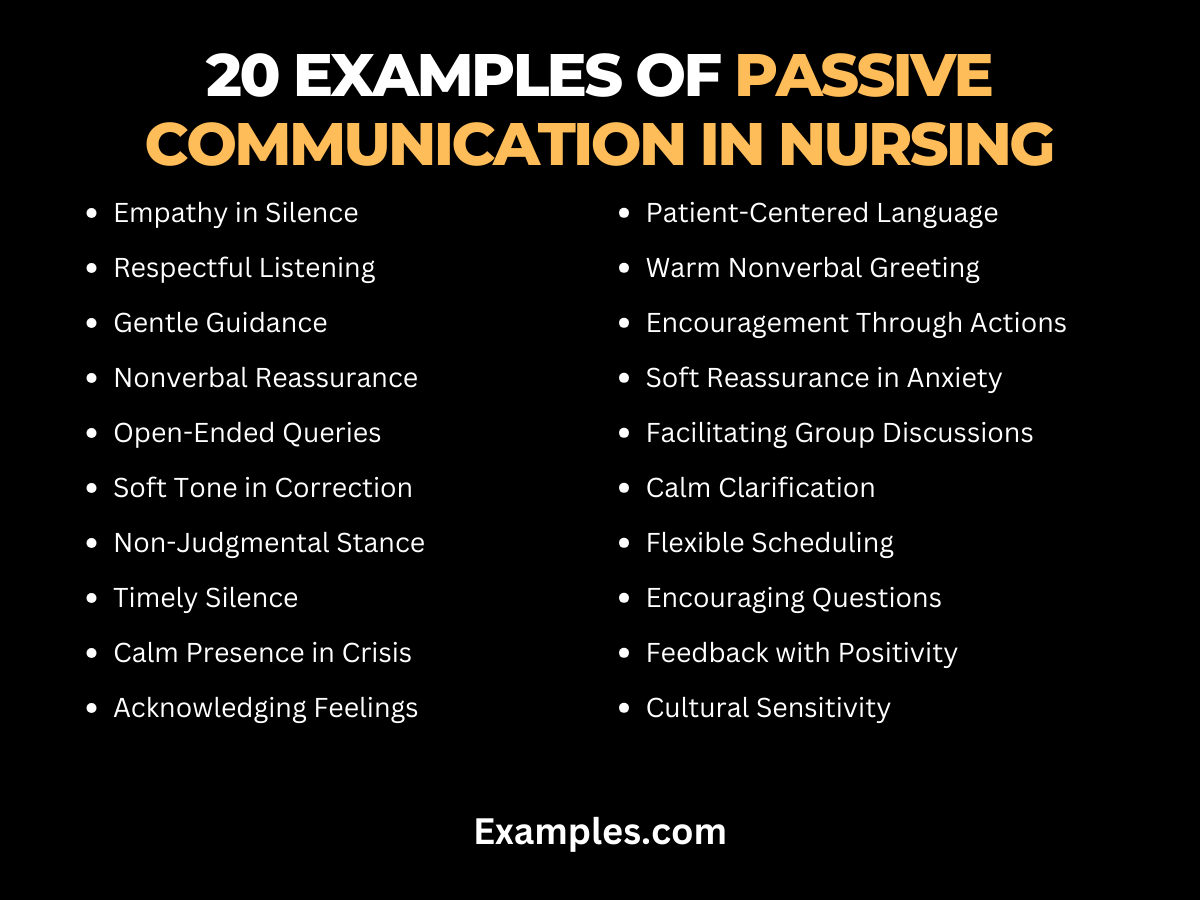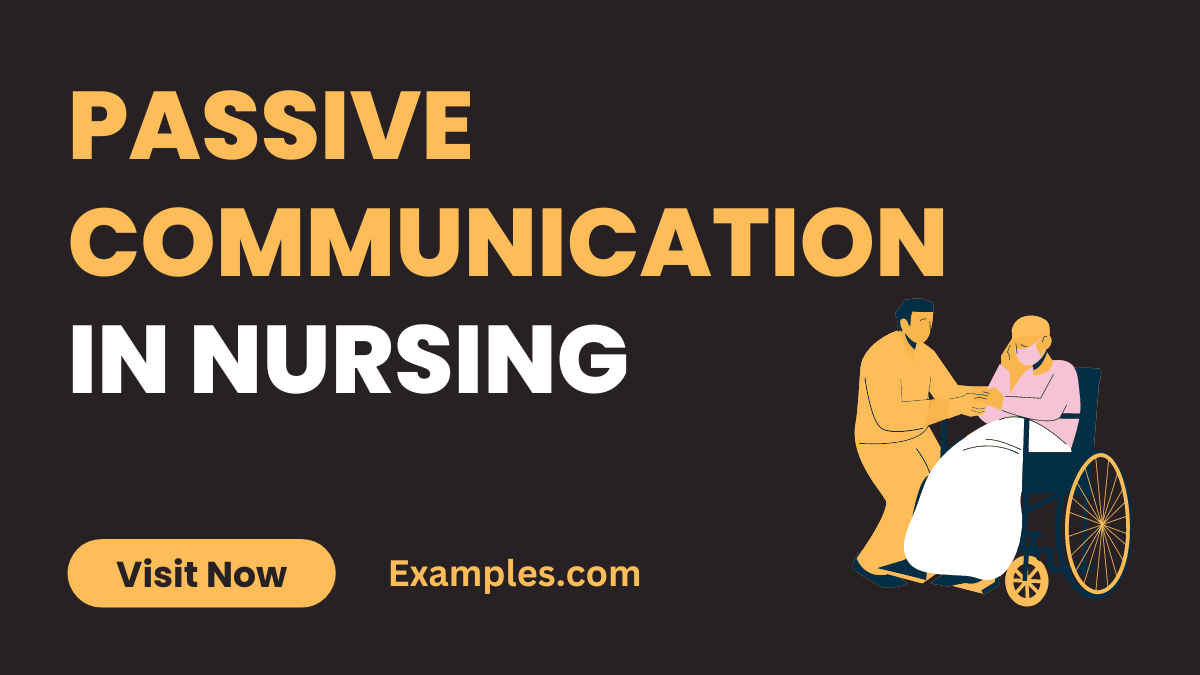19+ Passive Communication in Nursing Examples
Unlock the nuanced realm of Passive Communication in Nursing with our comprehensive guide. Delve into the intricacies of this communication style, understanding its role and impact in healthcare settings. Navigate through real-life Communication Examples to gain practical insights and foster effective connections within the nursing environment. Elevate your communication skills and create a positive, therapeutic atmosphere through passive communication strategies tailored for nursing professionals. Explore this complete guide for a transformative approach to nursing communication.
Passive Communication in Nursing: Definition

Passive communication in nursing is a communication style where individuals express their thoughts, needs, and desires in an unassertive, non-confrontational manner. In simpler terms, it involves a reserved approach that may avoid direct expression. This style aims to prevent conflict but can sometimes lead to misunderstandings. Understanding the nuances of passive communication is crucial in nursing, influencing the quality of patient care and professional relationships within healthcare settings.
20 Examples of Passive Communication in Nursing
Explore the advantages of Passive Communication in Nursing, a style fostering collaboration and therapeutic relationships. Uncover the benefits through real-life scenarios, enhancing your skills for effective healthcare communication. Elevate patient care with this nuanced approach.

- Empathy in Silence: In challenging moments, a nurse’s quiet presence speaks volumes, offering comfort without words.
- Respectful Listening: Acknowledge patients’ concerns patiently, showcasing respect for their perspectives and feelings.
- Gentle Guidance: Guide patients subtly, allowing them to make decisions while offering support and gentle suggestions.
- Nonverbal Reassurance: A reassuring touch or nod communicates understanding and support during difficult conversations.
- Open-Ended Queries: Encourage patient expression with open-ended questions, promoting honest and thorough communication.
- Soft Tone in Correction: Correcting errors with a soft tone maintains dignity and encourages a positive learning environment.
- Non-Judgmental Stance: Avoid judgment and criticism, fostering an environment where patients feel safe sharing their concerns.
- Timely Silence: Sometimes, allowing silence creates space for patients to process information and share their thoughts.
- Calm Presence in Crisis: Maintain a calm demeanour during crises, offering reassurance and stability to those in distress.
- Acknowledging Feelings: Validating patients’ emotions creates trust and strengthens the nurse-patient bond.
- Patient-Cantered Language: Use language that centres on the patient’s experience, ensuring clear and respectful communication.
- Warm Nonverbal Greeting: A warm smile and welcoming body language create a positive first impression for patients.
- Encouragement Through Actions: Support patient autonomy by encouraging self-care and independence in daily activities.
- Soft Reassurance in Anxiety: Addressing anxiety with a gentle touch or soothing words promotes a sense of security.
- Facilitating Group Discussions: Guide group discussions subtly, ensuring all voices are heard and respected.
- Calm Clarification: When patients are confused, calmly offer clarification without causing additional distress.
- Flexible Scheduling: Adjusting schedules to accommodate patients’ preferences demonstrates flexibility and patient-centric care.
- Encouraging Questions: Welcome patient questions openly, fostering an environment of shared decision-making and understanding.
- Feedback with Positivity: Provide constructive feedback with positivity, motivating improvement without discouragement.
- Cultural Sensitivity: Display cultural sensitivity by adapting communication styles to respect diverse backgrounds and beliefs.
Passive Communication in Nursing at Hospitals: A Delicate Approach
Unlock the subtleties of passive communication within hospital settings. This guide explores how nurses employ passive communication to build trust and foster therapeutic relationships, creating a conducive environment for patient care and collaboration among healthcare professionals.
- Silent Support in Emergency Rooms: A nurse’s calm presence without words provides reassurance during critical moments.
- Soft Guidance in Post-Surgery Recovery: Offering gentle suggestions empowers patients while ensuring a conducive healing environment.
- Nonverbal Comfort in Palliative Care: A touch or comforting silence speaks volumes, providing solace to patients in end-of-life care.
- Open-Ended Queries in Ward Rounds: Encouraging open-ended questions allows patients to express concerns, aiding comprehensive care.
- Cultural Sensitivity in Diverse Units: Adapting communication to diverse cultural backgrounds ensures inclusive and respectful patient interactions.
- Warm Reception in Paediatric Wards: A friendly smile and welcoming gestures create a positive atmosphere for young patients and their families.
- Flexibility in Oncology Care: Adjusting schedules to accommodate treatment preferences showcases flexibility and patient-centric care.
- Encouraging Independence in Rehabilitation: Supporting patient autonomy through encouragement fosters a sense of control and progress.
- Positive Feedback in Maternity Units: Providing constructive feedback with positivity promotes a supportive birthing experience.
- Soothing Reassurance in Mental Health: Addressing anxiety with a calm demeanour and gentle reassurance contributes to a therapeutic environment.
Passive Communication in Nursing for Students
Explore the role of passive communication in nursing education. This guide delves into how nursing students can incorporate passive communication techniques to enhance their learning experiences, improve patient interactions, and build effective relationships with peers and mentors.
- Patient-Cantered Language in Clinicals: Using language focused on the patient’s experience enhances understanding and empathy.
- Respectful Listening in Simulated Scenarios: Actively listening to simulated patient concerns cultivates crucial skills for real-world healthcare settings.
- Calm Clarification in Classroom Discussions: Providing clear explanations without causing distress ensures a positive learning environment.
- Gentle Guidance in Skill Labs: Offering subtle guidance empowers students to master skills while fostering confidence.
- Non-Judgmental Stance in Group Projects: Creating a non-judgmental space encourages open communication and collaboration among peers.
- Soft Tone in Peer Feedback: Delivering constructive criticism with a soft tone promotes a supportive and encouraging learning environment.
- Empathy in Nursing Research: Demonstrating empathy in research promotes a holistic understanding of healthcare challenges.
- Encouraging Questions in Lecture Halls: Welcoming student questions fosters an environment of curiosity and active engagement in learning.
- Flexible Study Groups: Adapting study group schedules to accommodate diverse student preferences promotes inclusivity and effective collaboration.
- Therapeutic Communication Workshops: Participating in workshops on therapeutic communication techniques equips nursing students with valuable skills for future practice.
What are the 4 Styles of Communication in Healthcare?
Effective communication in healthcare transcends simple exchanges; it encompasses diverse styles tailored to various situations. Explore the four distinct styles crucial for navigating the complex landscape of healthcare communication:
- Passive Communication: Passive communication involves a reserved, non-confrontational approach. Nurses utilizing this style aim to prevent conflict but should be mindful of potential misunderstandings. Examples include maintaining a calm presence during crises and providing silent support in emergency situations.
- Assertive Communication: Assertive communication strikes a balance between passivity and aggression. Nurses employing assertive communication express their needs and opinions clearly while respecting the perspectives of others. This style promotes open dialogue, collaboration, and positive relationships in healthcare settings.
- Aggressive Communication: Aggressive communication is characterized by assertiveness without empathy, often leading to conflict. Nurses should avoid this style, as it can hinder therapeutic relationships and compromise patient care. Recognizing and mitigating aggressive communication is essential for a harmonious healthcare environment.
- Assertive Communication: Assertive communication strikes a balance between passivity and aggression. Nurses employing assertive communication express their needs and opinions clearly while respecting the perspectives of others. This style promotes open dialogue, collaboration, and positive relationships in healthcare settings.
In conclusion, mastering passive communication in nursing is crucial for creating a compassionate healthcare environment. From nonverbal cues to therapeutic interactions, this guide provides a comprehensive understanding. By incorporating these examples, nurses can enhance patient care, strengthen professional relationships, and contribute to a positive and healing atmosphere within the healthcare setting.



